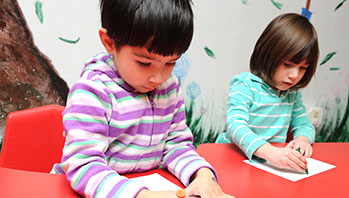- glue or tape
- large sheet of mural paper
- marker
- pieces of yarn from Discovery Time activity (Day 2)
- flow
- river
MA Standards:
Writing/W.PK.MA.2: Use a combination of dictating and drawing to explain information about a topic.
Mathematics/Measurement and Data/PK.MD.MA.1: Recognize the attributes of length, area, weight, and capacity of everyday objects using appropriate vocabulary (e.g., long, short, tall heavy, lights, big, small, wide, narrow).
Head Start Outcomes:
Literacy Knowledge/Early Writing: Uses scribbles, shapes, pictures, and letters to represent objects, stories, experiences, or ideas.
Approaches to Learning/Persistence and Attentiveness: Maintains interest in a project or activity until completed.
Approaches to Learning/Persistence and Attentiveness: Sets goals and develops and follows through on plans.
Approaches to Learning/Persistence and Attentiveness: Resists distractions, maintains attention, and continues the task at hand through frustration or challenges.
PreK Learning Guidelines:
English Language Arts/Composition 16: Use their own words or illustrations to describe their experiences, tell imaginative stories, or communicate information about a topic of interest.
Mathematics/Measurement 14: Use nonstandard units to measure length, weight, and amount of content in familiar objects.
Draw and Write Together: Make a Graph #2

© Commonwealth of Massachusetts, Department of Early Education and Care (Jennifer Waddell photographer). All rights reserved.
STEM Key Concepts: Taking measurements is a way of gathering information
ELA Focus Skills: Listening and Speaking, Vocabulary
Make a graph of children’s results from the measuring activity. Ask children to help you place each piece of yarn on the mural paper side by side, and glue them to the paper. Make sure that all of the pieces line up at the bottom.
Help children write “<child’s name’s> River” under their piece of yarn. Ask children, What does each piece of yarn tell us? (how far the water flowed)
Have children discuss the results. Encourage them to use the words far, farthest, shortest, longest, and flowed in their responses. Talk with children about why they think some rivers traveled farther than others. Have children share how they made their rivers flow.
Adaptation: For groups with very young children who are not yet writing their names, you may want to assign each child a sticker to designate his or her yarn piece.
Take It Further: Introduce and talk with children about the concept of precision when measuring and graphing. Ask, Why do you think it is important to make sure the yarn pieces start at the same place on the bottom on the graph? What would happen if they did not? How would the results change?
